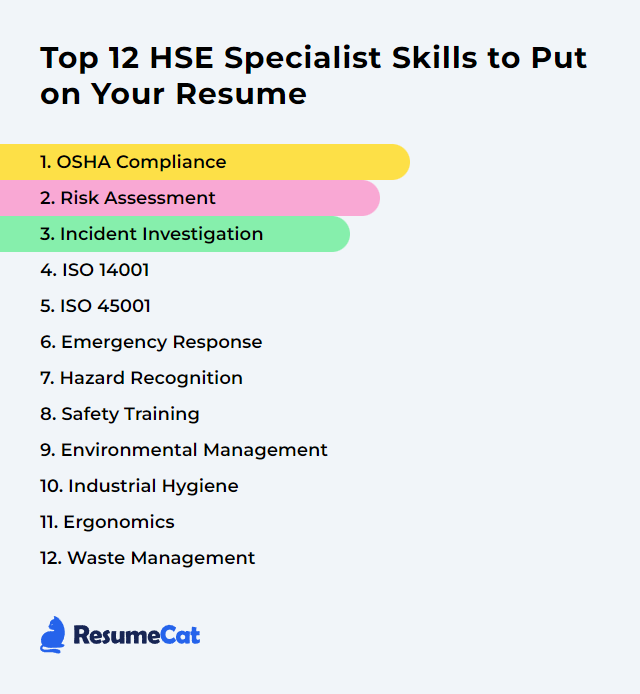Top 12 HSE Specialist Skills to Put on Your Resume
Jobs in Health, Safety, and Environment (HSE) reward people who can prove real-world skill, not just good intentions. Hiring managers scan fast. Strong, specific capabilities pop off the page. Use this guide to sharpen what you show, and how you show it, so your resume lands with weight in a crowded market.
HSE Specialist Skills
- OSHA Compliance
- Risk Assessment
- Incident Investigation
- ISO 14001
- ISO 45001
- Emergency Response
- Hazard Recognition
- Safety Training
- Environmental Management
- Industrial Hygiene
- Ergonomics
- Waste Management
1. OSHA Compliance
OSHA compliance means building and maintaining safe work conditions that meet regulatory standards. For an HSE Specialist, that spans programs, training, inspections, documentation, and steady follow-through so hazards don’t linger and injuries don’t repeat.
Why It's Important
It reduces harm, prevents fines and downtime, and proves the organization is serious about protecting people. The law matters. So do lives.
How to Improve OSHA Compliance Skills
Stay current: Track standard updates and interpretations; translate changes into clear procedures.
Train with intent: Deliver role-specific, hands-on training. Refresh it. Verify competency, not just attendance.
Audit relentlessly: Inspect with checklists, verify controls, correct quickly, and log everything.
Build safety ownership: Encourage reporting and near-miss sharing without blame. Recognize proactive behaviors.
Tighten recordkeeping: Maintain accurate logs, incident records, and corrective action tracking.
Leverage consultations: Use qualified internal or external experts for gap reviews, especially in higher-risk operations.
Do the basics well and do them often. Compliance sharpens when culture, training, and verification line up.
How to Display OSHA Compliance Skills on Your Resume
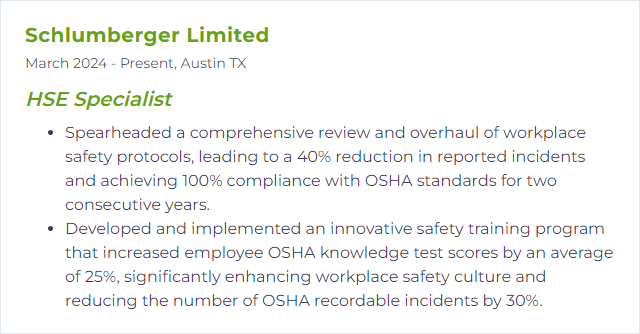
2. Risk Assessment
Risk assessment is the structured hunt for hazards, then the evaluation and control of the risks they pose. It’s methodical, evidence-based, and continuous.
Why It's Important
It prioritizes what truly matters. You can’t control every risk at once, so you rank them, act on the big ones, and keep trimming the rest.
How to Improve Risk Assessment Skills
Know the rules: Understand applicable regulations and industry practices for your operations.
Advance your methods: Use appropriate tools—JSA/JHA, bowtie, FMEA—based on complexity and consequence.
Use good data: Blend incident history, exposure measurements, maintenance data, and frontline input.
Involve people: Bring operators, supervisors, and maintenance into assessments. Context prevents blind spots.
Review often: Update assessments after change, incidents, or new information. Risks drift; keep pace.
How to Display Risk Assessment Skills on Your Resume
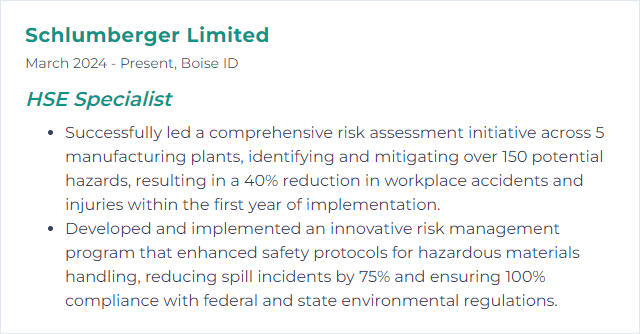
3. Incident Investigation
Incident investigation digs into events and near misses to uncover system causes, not just the last mistake in the chain. The aim: prevention that actually sticks.
Why It's Important
Root causes drive better fixes. When you solve the system issues, recurrence plummets and learning spreads.
How to Improve Incident Investigation Skills
Stabilize and preserve: Secure the scene, protect people, capture evidence quickly.
Plan the work: Set scope, roles, and timeline. Include cross-functional voices.
Collect broadly: Interviews, photos, documents, equipment data, procedures, training records—cast a wide net.
Analyze with structure: Apply methods like Five Whys, fishbone, or barrier analysis; verify with the team.
Write for action: Clear narrative, defensible causes, targeted corrective and preventive actions with owners and due dates.
Implement and verify: Track completion and effectiveness. If controls underperform, adjust.
Teach the lessons: Share findings and updates so the organization learns, not just the immediate crew.
How to Display Incident Investigation Skills on Your Resume
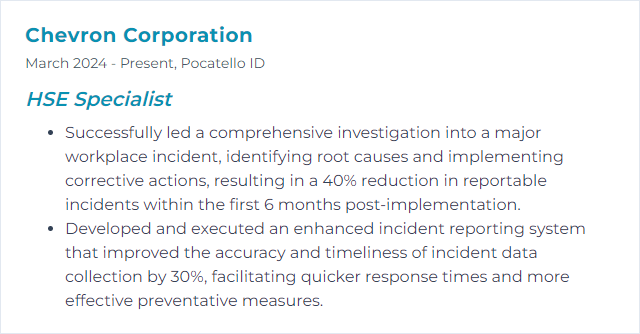
4. ISO 14001
ISO 14001 sets the blueprint for building an Environmental Management System that actually drives performance—less waste, better compliance, smarter use of resources.
Why It's Important
It organizes environmental work into a repeatable system. That means fewer surprises, clearer objectives, measurable progress, and credibility with stakeholders.
How to Improve ISO 14001 Skills
Run a gap assessment: Map current practice to the standard’s requirements; prioritize high-impact gaps.
Engage people: Train, clarify roles, and connect objectives to daily work so the EMS lives beyond a binder.
Optimize processes: Tighten controls around energy, water, emissions, waste, and procurement.
Use KPIs: Track meaningful indicators; review trends and course-correct.
Maintain legal compliance: Keep a current register, verify controls, and go beyond minimums when risks warrant.
Work the PDCA cycle: Plan, do, check, act—over and over, with documented learning.
Audit inside and out: Internal audits for depth; external audits for objectivity.
Apply technology: Use digital EMS tools and metering to sharpen data and decisions.
Hold management reviews: Align environmental goals with business strategy and resources.
How to Display ISO 14001 Skills on Your Resume
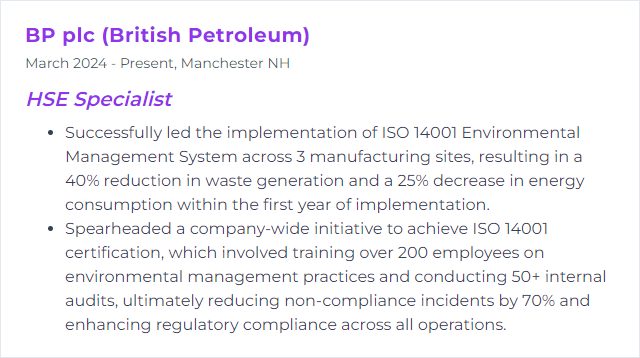
5. ISO 45001
ISO 45001 defines how an Occupational Health and Safety Management System should function so risks shrink, participation rises, and serious harm becomes rare.
Why It's Important
It turns safety from reactive firefighting into a managed, measurable system anchored in leadership and worker involvement.
How to Improve ISO 45001 Skills
Perform a gap review: Compare your OH&S system to the standard and fix the biggest weaknesses first.
Elevate participation: Build mechanisms for consultation, reporting, and action tracking that workers trust.
Strengthen risk controls: Address hazards at the source; favor engineering and substitution over administrative controls and PPE when feasible.
Train for competence: Make training practical, role-based, and assessed.
Measure performance: Use leading and lagging indicators; review routinely.
Hold management reviews: Test suitability and effectiveness, then set sharper objectives.
Keep improving: Feed findings from audits, incidents, and suggestions back into the system.
How to Display ISO 45001 Skills on Your Resume

6. Emergency Response
Emergency response is the coordinated snap-back to abnormal events—control the scene, care for people, protect the environment, restore operations.
Why It's Important
Seconds matter. Good planning and practiced execution reduce chaos, damage, and fear.
How to Improve Emergency Response Skills
Drill regularly: Tabletop and full-scale exercises. Vary scenarios. Evaluate realism and timing.
Strengthen communication: Redundant channels, clear roles, and plain-language alerts. No guesswork.
Refine the ERP: Keep an up-to-date Emergency Response Plan with evacuation routes, shutdown steps, responsibilities, and continuity measures.
Stage equipment: Inspect and maintain extinguishers, spill kits, first aid supplies, and emergency power. Accessible, labeled, ready.
Coordinate externally: Build relationships with local responders. Share site hazards, maps, and contacts; run joint drills when possible.
Debrief and improve: After actions, capture lessons, assign fixes, and verify completion.
How to Display Emergency Response Skills on Your Resume

7. Hazard Recognition
Hazard recognition is the craft of spotting dangers before they bite—obvious ones, sneaky ones, and the quiet degradations that stack up over time.
Why It's Important
You can’t control what you don’t see. Early identification prevents incidents and simplifies controls.
How to Improve Hazard Recognition Skills
Train eyes and minds: Teach patterns of harm across physical, chemical, biological, and ergonomic risks.
Walk the work: Frequent inspections, task observations, and hazard hunts with the people who do the job.
Use tech: Digital checklists, photo capture, and mobile reporting to speed visibility and follow-up.
Engage the team: Safety huddles, suggestion channels, and recognition for sharp spotting.
Keep learning: Review incidents from your site and your industry to broaden pattern recognition.
How to Display Hazard Recognition Skills on Your Resume
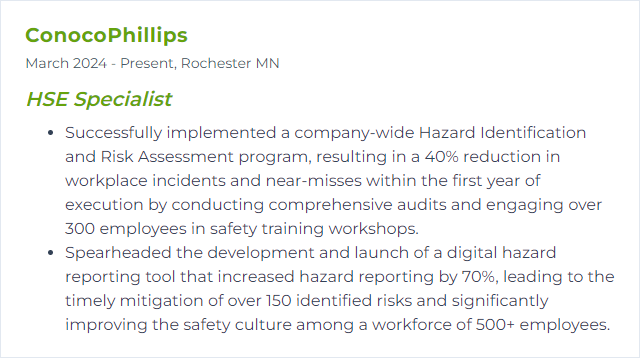
8. Safety Training
Safety training equips people to do risky work safely, consistently, and confidently. It’s not slides; it’s behavior change.
Why It's Important
Competence reduces injuries and errors. It also anchors culture—what “right” looks like when no one is watching.
How to Improve Safety Training Skills
Make it interactive: Simulations, scenarios, micro-drills. People remember what they do.
Customize by role: Tailor content to tasks, exposures, and equipment. Ditch generic filler.
Blend formats: Short e-learning for refreshers, hands-on practice for critical tasks, quick toolbox talks for reinforcement.
Measure learning: Check understanding with practical assessments, not just quizzes.
Close the loop: Use feedback, incident trends, and observations to adjust content.
Recognize achievement: Credentials or badges can motivate and signal competency to supervisors.
Get leaders involved: When managers show up and model expectations, training sticks.
How to Display Safety Training Skills on Your Resume
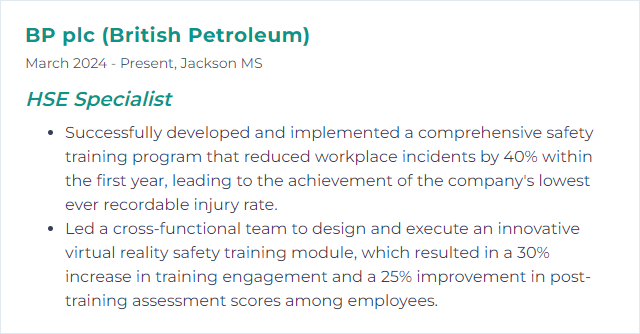
9. Environmental Management
Environmental management plans, controls, and improves how operations interact with air, water, land, and resources. It’s compliance and stewardship together.
Why It's Important
It protects ecosystems, reduces waste and cost, and builds trust with communities and regulators.
How to Improve Environmental Management Skills
Track requirements: Maintain a current legal and other requirements register for your activities.
Assess impacts: Conduct impact/risk assessments for processes and changes; prioritize significant aspects.
Systematize: Use an EMS framework to define objectives, controls, monitoring, and responsibilities.
Educate: Train employees on relevant controls—spill prevention, waste segregation, energy practices.
Monitor and report: Collect reliable data on emissions, waste, and resource use; share results and progress.
Engage stakeholders: Communicate with employees, suppliers, and local communities; invite feedback.
Audit and improve: Use audits and management reviews to tighten controls and raise ambition.
How to Display Environmental Management Skills on Your Resume
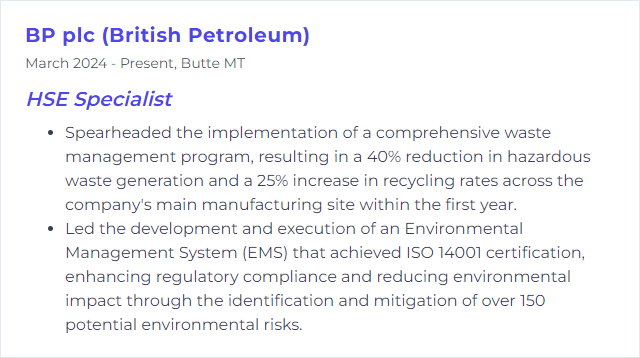
10. Industrial Hygiene
Industrial Hygiene anticipates, recognizes, evaluates, and controls workplace exposures—chemical, physical, biological, and ergonomic—so people stay healthy long-term.
Why It's Important
Acute injuries make headlines; chronic exposures quietly harm. Good hygiene programs prevent both.
How to Improve Industrial Hygiene Skills
Assess exposures: Survey tasks, measure as needed, and characterize risk by task and worker group.
Control smartly: Favor elimination, substitution, and engineering controls. Use admin controls and PPE where required, with fit and use verified.
Ventilate well: Design, maintain, and test ventilation and capture systems to keep contaminants down.
Promote hygiene habits: Handwashing, decontamination, housekeeping, and proper storage reduce secondary exposure.
Train and refresh: PPE use, chemical handling, noise protection, and emergency procedures should be practiced, not just read.
Health surveillance: Implement appropriate medical monitoring for higher-risk exposures, respecting privacy and ethics.
Improve continuously: Audit controls, review data trends, and adapt to new materials and processes.
How to Display Industrial Hygiene Skills on Your Resume
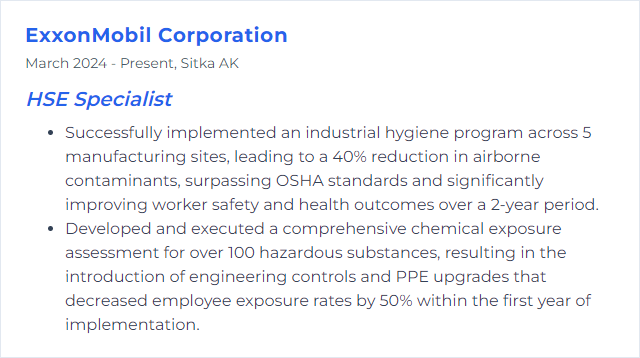
11. Ergonomics
Ergonomics shapes work to fit people—reducing strain, improving comfort, and boosting output without grinding bodies down.
Why It's Important
Fewer musculoskeletal disorders, smoother operations, happier teams. Small adjustments can pay off fast.
How to Improve Ergonomics Skills
Assess tasks: Use tools like RULA or the Quick Exposure Check, plus direct observation and worker input.
Modify the setup: Adjustable stations, lift assists, better handles, job rotation, and tool redesign where needed.
Coach technique: Teach posture, reach zones, neutral wrist positions, and safe lifting—with practice.
Breaks and micro-movements: Short stretch pauses beat long, infrequent rests for repetitive work.
Iterate with feedback: Monitor discomfort reports and tweak controls until complaints fade and metrics improve.
How to Display Ergonomics Skills on Your Resume
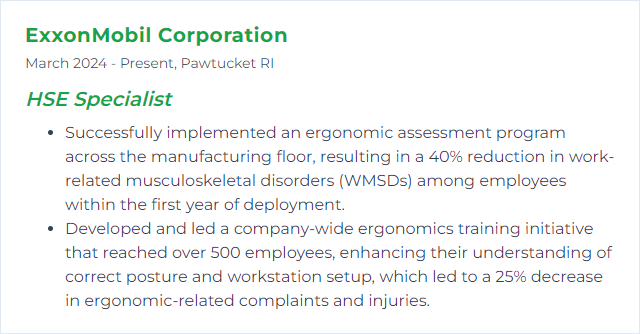
12. Waste Management
Waste management governs how materials are minimized, segregated, handled, stored, transported, treated, and disposed—safely and in line with rules.
Why It's Important
It protects people and the environment, trims costs, and signals operational discipline.
How to Improve Waste Management Skills
Audit waste streams: Quantify types and volumes; target the biggest and riskiest first.
Reduce at the source: Improve processes, specs, and purchasing to prevent waste before it exists.
Apply the 3Rs: Prioritize reduce, then reuse, then recycle with clear procedures and infrastructure.
Segregate correctly: Separate hazardous from non-hazardous, recyclables from general waste, and label clearly.
Train and enforce: Practical training for handling, labeling, and storage. Spot-check and correct.
Use technology: Tracking systems for volumes, costs, and compliance deadlines improve control.
Partner wisely: Vet waste vendors, verify permits, and audit performance periodically.
How to Display Waste Management Skills on Your Resume

